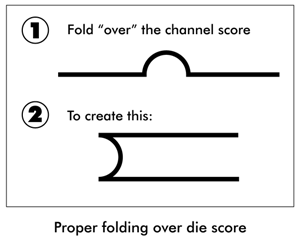| File Upload Home | Contact | Site Map |
|
|

 |
Apple Pie & Chevrolet? How about Die Cutting & Foil Stamping? When things go hand in glove, they just fit. Well, here’s another one for your list. Die cutting and foil stamping are like two peas in a pod. OK, enough with the old sayings. Successful projects don’t just happen. They are the result of meticulous planning every step of the way from the design phase to the finishing stage. When projects call for maximum impact, consider combining die cutting and foil stamping. However, if you do, be prepared to launch a well-coordinated effort to ensure that your project is flawlessly executed. Pre-planning is essential for projects with multiple finishing techniques. After you conceptualize how the final piece should look, your finisher should examine the design so a strategy and timeline can be mapped out. Then, it’s critical that your finishing partner thoroughly review the job at the estimating stage as well as when it lands on their loading dock. Die cuts can be simple and standardized, like standard pocket folders, or unique customized designs for mailers, promotions, inserts and book covers. If you want to save a few bucks on your die, how about choosing one from your finisher’s existing inventory? If they’re good at what they do, you should have options galore. Another key factor in the diecutting process is selecting the right paper stock and making sure the inks and coatings are receptive to the foil process. On the die cutting side, choosing the right finisher is critical, especially when light weight stocks are involved since the newest technology in diecutting presses makes running light stocks easy. If the finisher is using old equipment, it will be a struggle and your finished piece will suffer because of it. Foil Stamping Foil stamping grabs attention and is a popular choice for book covers, letterhead, pocket folders, cards or any piece that needs to stand out. Making the right decisions up front can help your foil stamping project sail through the finishing house. Communicate with your finisher to make sure your foil selections will work with your chosen paper stock. Coated paper stocks are more naturally receptive to foil, but the softer uncoated stocks also work well with the proper foil selection. Before a project is printed, let your finisher help you select a stock that will yield optimum stamping results. The world of foil is vast and nearly endless. Choose from golds, silvers, bronzes and other metallics, reds, whites, blues, blacks and other colors, smokes, clears, pearls and other tints, holographics, neons, wood grains and other special effects. Remember each foil also has different finishes and light refracting characteristics. Given these considerations, your finisher can advise you on what foil best matches your needs. Now that your job is stamped beautifully, let’s move to the next process.
Die Cutting If a work-and-turn or work-and-tumble printing layout works best from a printing standpoint, be aware that you should let you die cutter know this during the quoting and job planning stage. Proper channel scoring requires that folds are made “over” the channel score, not “under.” If stacked, the beads of the scores of each form must nest into those directly behind it. Both work-and-turn and work-and-tumble print formats cannot be properly die-scored unless they are cut apart first. Keep grain direction in mind, not for die cutting, but again for downstream folding. When cross grain folds are improperly laid out on some recycled stocks, cracking may result but the channel score usually helps eliminate this problem. The best way to prevent problems on your great looking jobs involving both foil stamping and die cutting is to discuss the intended project with your finisher. They do a great job of pouring over all the details and often notice potential trouble areas. While there is no one-size-fits-all approach, careful planning should do the trick. So go grab that pie and eat it in your fancy Chevrolet. * * * Greg Ortmann is president of Feiereisen, Inc., a leading provider of post press and finishing services including diecutting, scoring and perforation, tabcutting, all types of mechanical binding, folding, gluing, board and litho mounting, film lamination and UV coating, foil stamping, embossing and more. Founded in 1933, Feiereisen has locations in Cedar Rapids, Iowa, Des Moines, Iowa and Kansas City, Kansas.
|
 |
||
